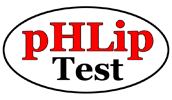Instructions
Preparing to conduct a pHLip Test:
- Perform the test on finished biodiesel only. Unwashed biodiesel will not pass.
- Perform the test only on biodiesel that is at room temperature. Do not use hot or cold biodiesel.
- The test can be performed on B100 and B99.
- You may need a wrench to remove the cap from the vial. We use a nitrogen blanket and then machine tighten the cap in order to prevent oxidation of the pHLip Test ingredients.
- Gently flip the vial ten times, end over end, using only wrist action.
- The harder you shake vial, the longer it takes to read the results. Dr. Randall von Wedel found that 10 gentle flips using wrist action alone provided the mixing needed to be able to read the test in 10 minutes.
- Wait 10 minutes after adding the biodiesel and flipping to read your result.
- You will get further test results 24-48 hours after performing the pHLip Test.
- After the test, empty the vial completely, because over time, the biodiesel in the vial will go turbid and the red will shift to yellow.
- Do not flip the test a second time. It most likely will not provide you with the same results after a second shake
- Use the squeeze bulb to transfer biodiesel to a pHLip Test. Fill nearly to the top, leaving an air space.
- Tighten the cap and flip the vial gently ten times. REMEMBER: Gently flip the vial ten times, end over end, using only wrist action.
- Wait 10 minutes.
- Observe the test results in three areas:
- The color and clarity of the indicator solution
- The interface between the fuel and the indicator solution
- The clarity of the fuel
Results
Clarity
- Look for "clear and bright" fuel floating above the indicator solution with a crisp, rapid separation from the water phase below. High quality biodiesel will quickly separate from the water phase and provide you a clear, bright transparent fuel. The chemicals in the indicator solution simply enhance the visual signal of the hydrated contaminants and accelerate their precipitation onto the interface.
- The indicator solution should remain "cherry red" (neutral pH) and have little or no turbidity (cloudiness). Some fuels will cause mild turbidity as they approach the ASMT limit of 0.24% Total Glycerin.
- Most common dissolved contaminants are the monoglycerides, followed by residual di- and triglycerides remaining in the fuel from the transesterification reaction. Water washing is not effective in removing these incomplete reaction products. If a fuel is not completely reacted, it would have to be polished (by ion exchange resin filtration, for example) to remove these last traces of intermediate products.
- Traces of sterol glucosides in soy and other virgin vegetable oil products can also contribute to the cloudiness of the fuel layer, particularly if there are significant levels of monoglycerides present. In the pHLip Test, these molecules become hydrates and tend to nucleate to form turbidity and then will gradually settle out on the water-fuel interface as white, wispy precipitates that look like tiny clouds.
- Turbidity indicates dissolved contaminants are present that were invisible in the fuel. Most contaminants cause the fuel to absorb water and become cloudy.
- If the red indicator solution becomes turbid, you can suspect soap or other water soluble contaminants.
- High quality ASTM B100 will create a "mirror finish" on the smooth interface between the fuel and indicator solution — If you see a good reflection, you have good clean fuel!
- Over time, contaminants may concentrate on the interface ("lens effect").
- Again, the indicator solution should remain "cherry red", meaning a neutral pH.
- If the indicator turns orange or yellow, this indicates acid accumulation, which means the fuel (or the feedstock used to make the fuel) is probably aged.
- Some fuel stabilizers, added after production, may also turn the indicator orange. It may or may not be out of spec and should be tested. Please contact our laboratory for details about this, or see below.
- If the indicator color turns a deeper purple, you have a hydroxide catalyst contamination – deadly to the seals, gaskets and O-rings of your engine’s fuel injection system. This is exactly how the pHLip Test was developed, as a safeguard against catalyst contamination that was destroying truck engines!
- If the fuel is slightly turbid, but the indicator solution is transparent and of normal cherry color, you probably have slightly aged fuel or traces of glycerides or glycerin left from the production process.
Downloads
For more explicit instructions and explanations on the multiple visual indications of the pHLip Test, click here.
Once you have taken a Biodiesel pHLip Test, to assure the specific parameters, you make consider having a Biodiesel Quality Status Report (BQSR) completed by CytoCulture. Click here to see an example report.
If you would like to proceed with a BQSR, please contact CytoCulture International.
